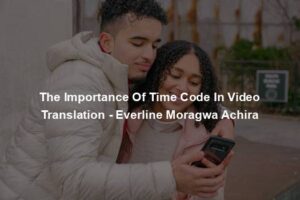Audio-Visual Translation – What Is It About.mp3 transcript powered by Sonix—easily convert your audio to text with Sonix.
Audio-Visual Translation – What Is It About.mp3 was automatically transcribed by Sonix with the latest audio-to-text algorithms. This transcript may contain errors. Sonix is the best audio automated transcription service in 2020. Our automated transcription algorithms works with many of the popular audio file formats.
The dubbing King software presents audio visual translation. What is it about a comprehensive guide? A brief synopsis of audio visual translation. Audio visual translation is just one possible job specialization of many that we can find as professional translators, although the majority of audio visual work is in English. There are sometimes opportunities to do projects in German, French and other languages. To this certain kind of translation always caught my attention and I wanted to do some research on its theoretical side. Audio visual translation is as follows. What is audio visual translation? Audio visual translation. A V.T. is the term used to refer to the transfer from one language to another of the verbal components contained in audio visual works and products. Feature films, television programs, theatrical plays, musicals, opera web pages and video games are just some examples of the vast array of audio visual products available and that require translation, as the word suggests. Audio visual Zah made to be both heard audio and seen visual simultaneously, but they are primarily meant to be seen. What are the characteristics that define audio visual translation? Some of the typical characteristics that define audio visual translation are speech and changing registers. One speech with this characteristic, we refer to the ability to symbolize a previously translated, natural and spontaneous dialogue. It might sound easy, but it is not. What is logical to one person in a certain context might seem totally out of place for another person.
For that reason, a translator should be able to transfer written language onto the screen without adding strange expressions or demanding and unreasonable, unnatural efforts on the part of the character who is speaking to changing registers. Contrary to the other specialized forms, audio visual translation is characterized by suffering from changes in registers. Instead of working on a well-defined topic, we are confronted with a great variety of possible registers. Among these are children's programs, detective series, horror movies or documentary films. On nature, one of audio visual translations advantages is that it permits the translator to learn something new about any possible topic every day. That is why it is not surprising that translators often have a wide and pretty broad cultural and general knowledge modalities of audio visual, translation, synchronization and subtitles, synchronization and subtitles. There has always been a debate about which of the two is the more adequate and appropriate form. From my point of view, both have their pros and cons. Synchronization is the oral adaptation of an audio visual document in which you do not have any traces of the original language. On some occasions, though, we will find cultural collocations that simply do not apply in this case. It is necessary to blend in some kind of image or representation of the words in order to get the best results. On the other hand, the original language remains present in an audio visual document that works with subtitles.
The targeted language also is represented by subtitles underneath the visual sequences due to globalization and the wide availability to access movies and series from other countries. There is a cultural opening in which subtitles gained popularity over the more traditional synchronization, overlaid voices, overlaid voices. It is not unusual today to watch a television program in which you can hear the characters speak in their maternal language whilst you hear and overlayed voice. That translates what has already been said. This kind of translation can especially be found in reality shows or documentaries. It is said the principal function of a Noval aid voice is to introduce the viewer to a different culture and the theme of the program. Audio description and subtitles for deaf people. Audio description and subtitles for deaf people. This kind of audio visual translation consists of subtitling for a hearing impaired audience. That is why elements like the description of sounds rather than just conversations between people need to be included as well. This means that, for example, size will be indicated in a different manner from the conversational content related subtitles. In some programs, they tend to mix this kind of translation with the interpretation of sign language dot localisation. This is probably the most unknown form of audio visual translation. It's consists of translating into.
All elements of Web sites, video games, software and other audio visual documents to provide a better consumer approved product in a certain country, it is exported to. Important tips for smooth audio visual translation. Avoid the overuse of colloquialism, translate cultural references adequately, and thus know the cultures of your working languages. Well, translate onomatopoeia with equivalent sounds in the target language if they exist. Become acquainted with sources out of the field, known experts in the area to which you are translating as well as conventional sources. For example, if translating a text on the law, it would be beneficial to contact any friends or contacts you have in that field to help with any terminology you are not familiar with, which are the most prevalent forms of audio visual translation. Audio visual translation. A V.T. is developing the translation activity in a context characterized by the interaction of text, whether oral or written with sound and image. Within this type of translation, the two most popular areas are the dubbing and subtitling whether use of one or the other depends on the different markets. For example, in Spain, almost all video, film, series, documentary in foreign Navy documents are usually dubbed into Spanish. In certain areas, even cinemas offer virtually no films in the original version, with subtitles with the only option available being the dubbed version. Both have their pros and cons from the point of view of the translator as the target audience.
From the perspective of a translator, dubbing allows the continuity of the film. Playing dialectal elements reflects the use of puns and irony or sarcasm, but shares the difficulty of having to coordinate the words in the target language with the movement of the actors lips. The difference making touches also because maybe you're watching a film set in China played by Chinese who are nevertheless communicating in Spanish. The advantage for viewers is that they do not have to concentrate more on the film and have to divide their attention between watching the movie and the letters that appear below in the case of subtitling. Moreover, that translator who is dedicated to subtitling has a number of limitations, since it is always necessary to translate what a character says in a few words and in a limited time, because the viewer has to have enough time to read the message before moving to the next. But drag for the viewer is constantly paying attention to the text rather than the image. So important non textual messages of the visual document in question can be lost. That is why, in this context, it is especially important to use qualified and specialized professionals in the audio visual field use to deal with these problems that can ensure that the transmission of the message is as faithful to the original as possible.
Automatically convert your audio files to text with Sonix. Sonix is the best online, automated transcription service.
Sonix uses cutting-edge artificial intelligence to convert your mp3 files to text.
Create better transcripts with online automated transcription. Sonix converts audio to text in minutes, not hours. Create and share better audio content with Sonix. Automated transcription is much more accurate if you upload high quality audio. Here's how to capture high quality audio. More computing power makes audio-to-text faster and more efficient. Sometimes you don't have super fancy audio recording equipment around; here's how you can record better audio on your phone. Sonix takes transcription to a whole new level. Here are five reasons you should transcribe your podcast with Sonix.
Sonix uses cutting-edge artificial intelligence to convert your mp3 files to text.
Sonix is the best online audio transcription software in 2020—it’s fast, easy, and affordable.
If you are looking for a great way to convert your audio to text, try Sonix today.
Other Podcasts




